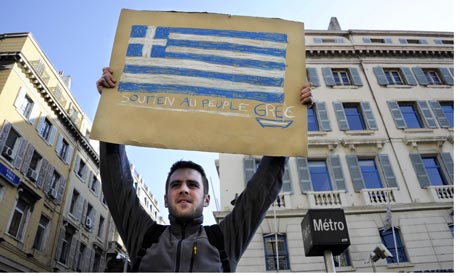
Antoine Arnault, CEO of Berluti, and his wife Natalia Vodianova visit Notre-Dame de Paris after the fire. Photograph: POOL/Reuters
In 2017, a welter of stories appeared in the international press pointing out the brokenness of Paris’s Notre Dame. Cathedral officials showed journalists how patches of limestone would crumble at a finger’s touch. Gargoyles that had lost their heads were patched up with plastic pipes, while fallen balustrades were replaced with wooden planks. All this decay was caused by pollution, acid rain and eight centuries of use – but also official neglect was to blame. Keepers of the building had begged for more money, but neither the belt-tightening French government nor the wealthy grumbling about higher taxes gave enough.
Then came Holy Week 2019 and the inferno by the Seine and all of a sudden, nobody can give too much. After years of preaching the shrinking of the public sector, the French president, Emmanuel Macron, now wants to mobilise the full resources of the state to get the roofless cathedral rebuilt within just five years. And money from France’s billionaire class keeps raining down. In three days, the cathedral has been pledged €100m (£86m) from Francois-Henri Pinault, the ultimate owner of Gucci and Yves Saint Laurent; €200m (£172m) from the Arnault family of Louis Vuitton fame; another €200m from L’Oreal owners the Bettencourt Meyers family, and €100 from French oil giant Total.
From these two episodes just two years apart, we can draw two conclusions. The first is that what is happening this week is a remarkable display of public-sector coordination and private generosity, in the service of a great thing: the restoration of one of the world’s treasures. And the second is that the rebuilt cathedral will be a monument to the gigantic hypocrisy of austerity politics.
In 2017, a welter of stories appeared in the international press pointing out the brokenness of Paris’s Notre Dame. Cathedral officials showed journalists how patches of limestone would crumble at a finger’s touch. Gargoyles that had lost their heads were patched up with plastic pipes, while fallen balustrades were replaced with wooden planks. All this decay was caused by pollution, acid rain and eight centuries of use – but also official neglect was to blame. Keepers of the building had begged for more money, but neither the belt-tightening French government nor the wealthy grumbling about higher taxes gave enough.
Then came Holy Week 2019 and the inferno by the Seine and all of a sudden, nobody can give too much. After years of preaching the shrinking of the public sector, the French president, Emmanuel Macron, now wants to mobilise the full resources of the state to get the roofless cathedral rebuilt within just five years. And money from France’s billionaire class keeps raining down. In three days, the cathedral has been pledged €100m (£86m) from Francois-Henri Pinault, the ultimate owner of Gucci and Yves Saint Laurent; €200m (£172m) from the Arnault family of Louis Vuitton fame; another €200m from L’Oreal owners the Bettencourt Meyers family, and €100 from French oil giant Total.
From these two episodes just two years apart, we can draw two conclusions. The first is that what is happening this week is a remarkable display of public-sector coordination and private generosity, in the service of a great thing: the restoration of one of the world’s treasures. And the second is that the rebuilt cathedral will be a monument to the gigantic hypocrisy of austerity politics.

Francois-Henri Pinault, pictured with his wife, Salma Hayek, has pledged €100m to Notre Dame. Photograph: Nina Prommer/EPA
A heritage site that roused barely a shrug two years ago means the world this week. A billionaire class that shrieked at the wealth taxes of the former president François Hollande is happy to stump up whatever it takes now. A politician, Emmanuel Macron, who has repeatedly told the poor they must live on less and the workers that they must give more to bosses, now plays at being a national leader – like Charles de Gaulle with more hair wax. And a capital city that over the past few months has been under siege from the working poor of the gilets jaunes is reminded once again of the enormous wealth held by a very few of its citizens. Everything that was impossible as late as 2017 is now deemed essential in 2019.
Of course, we would prefer private millions to be pulled out from under goose-feather pillows and spent on public works. But we should also be asking why it takes an almighty conflagration to force this to happen; and why those generous donors are so averse to giving their money to democratically chosen priorities, which is what taxes represent. If the ultra-rich can chuck in so many millions of euros for a building, then what stops them ending hunger and poverty?
Few want to ask that question, nor the obvious follow-up about how much the mullti-billion-owning Catholic church will stump up. The press prefer instead to boggle at the nine-figure sums that have been magicked up, while Macron and others congratulate the donors without asking where that money came from. Some go further still. The editor of Moneyweek went so far as to remark on social media: “Billionaires can sometimes come in really handy.” Well, yes. And democracy can be such a downer and greater equality a massive drag.
But for those who care to look, there is plenty here that is ugly. No sooner had Pinault pledged his €100 million, then his consigliere, Jean-Jacques Aillagon, sprang forth to suggest that all such donations should receive a 90% tax deduction. In other words, the French public should pay for most of its beloved billionaires’ generosity. The suggestion was swiftly withdrawn, but its proposer is no naïf. A former culture minister, Aillagon knows that charitable giving in France attracts a 60% tax rebate: so for every €100m some industrialist papa gâteau wants to chip in, the public will pay €60m. At least Reuters reports that the Pinault family is sitting out this particular round and not claiming tax relief.
Then there’s the source of that €200m pledge from France’s richest man, Bernaud Arnault, who just a few years ago was reported to be applying for Belgian nationality. This was not to enjoy any tax advantages, said his spokesman, but purely to better order his affairs. Nothing to do with the fact that inheritance tax in Belgium is only 3%, while France charges 11%, non monsieur.

Such ghastliness is not France’s alone. It is international and it is orthodoxy. Just look at Thursday’s Guardian lead story on how 1% of people in England own 50% of its land. Or remind yourself of the Oxfam finding that last year, the world’s 2,200 billionaires got 12% wealthier, while the bottom 3.5 billion people grew 11% poorer. Those at the top extract their wealth from those below – and then are applauded when they chuck us their spare change. From here it is just a short selfie-stick shuffle to a rebuilt Notre Dame boasting an Arnault gallery and a L’Oreal visitor centre. I’m joking, you snort. In which case, let me take you to the Sackler gallery at London’s Serpentine, generously donated by the family that extracted millions from opioid addiction.
Not least among this litany of ironies is that it takes a Catholic cathedral to remind us that we have barely advanced an inch from the medieval buying of indulgences, when the rich could amass their fortunes in as filthy a fashion as they liked – and then donate to the Church to launder their reputations and ensure their salvation. What was it that old Friar Tetzel used to say? “As soon as gold in the coffer rings, the rescued soul to heaven springs.”


